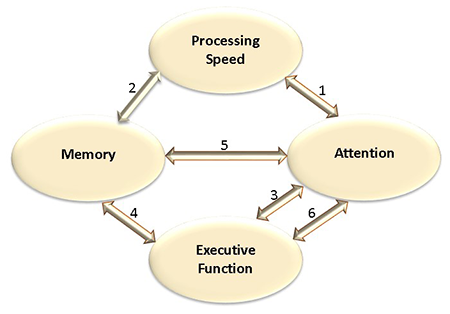Understanding cognitive dysfunction requires some background in cognitive function – knowing how the pieces fit together helps explain what happens when one or more of those pieces stops working well. We have different cognitive functions, each of which support and impact one another.
When neuropsychologists talk about cognitive functioning, we are referring to six main categories:
- Attention (the ability to focus on the task at hand)
- Processing Speed (how quickly the brain can take in information and respond to it)
- Memory (the ability to store information and retrieve it when needed)
- Executive Function (the process by which the brain organizes, plans, and executes tasks)
- Language (including both receptive and expressive ability)
- Visual-spatial Processing (the ability to understand and process information from shapes and orientation)
Different parts of the brain control different functions, but an impairment in any one of these cognitive functions will negatively impact all of them. And since most neurological pathologies – including stroke, injury, tumor, or even different types of treatments – can lead to disruptions in one or more of these categories, it is common to see some degree of cognitive dysfunction after any neurological event.
Processing Speed and Attention are the categories of cognitive functioning most impacted by neurological pathologies, and a neurological illness, injury, or treatment may hasten the diminishment in these categories that is already a part of normal brain aging. In addition, since emotional functioning is connected to cognitive functioning, anxiety and depression (either pre-existing or resulting from the illness, injury, or treatment) can further contribute to difficulties with Processing Speed and Attention.
The cognitive functions of Processing Speed, Attention, Memory, and Executive Function are related, which is why a disturbance in one category can lead to trouble with all three. Here’s how that happens:
- Relationship between Processing Speed and Attention: A slowing of Processing Speed leaves the brain more vulnerable to distraction, since the brain is less able to switch quickly from one task to another and then back to the original task. It is harder for anyone to get back on track once distracted.
- Relationship between Processing Speed and Memory: A slowing of Processing Speed also contributes to a bottleneck effect, in which there may be important information left unprocessed. Unprocessed information never makes it into memory storage, so there is nothing to retrieve later. Slowed Processing Speed also contributes to delays in retrieving information from memory, which may lead to the “giving up” effect, in which an individual stops trying to retrieve information before they’ve given themselves enough time to come up with it.
- Relationship between Executive Function and Attention: Diminished Executive Functioning can contribute to not directing oneself to attend to what is important.
- Relationship between Executive Function and Memory: Diminished Executive Functioning contributes to not organizing the information as it’s being stored in memory, making it more difficult to retrieve that information later.
- Relationship between Attention and Memory: If someone has Attention problems, the brain might not be attending to new information long enough to fully process it into memory storage. When a person’s Attention is elsewhere, information is not fully processed and stored into memory.
- Relationship between Attention and Executive Function: Diminished Attention makes it difficult to complete tasks without making errors, and it’s easy for someone with Attention deficits to become distracted and lose track of what they’re doing in the middle of the task. Without well-functioning Attention it’s difficult to keep the steps of a task available while performing it, and once interrupted it is difficult to get back to the task at hand.
